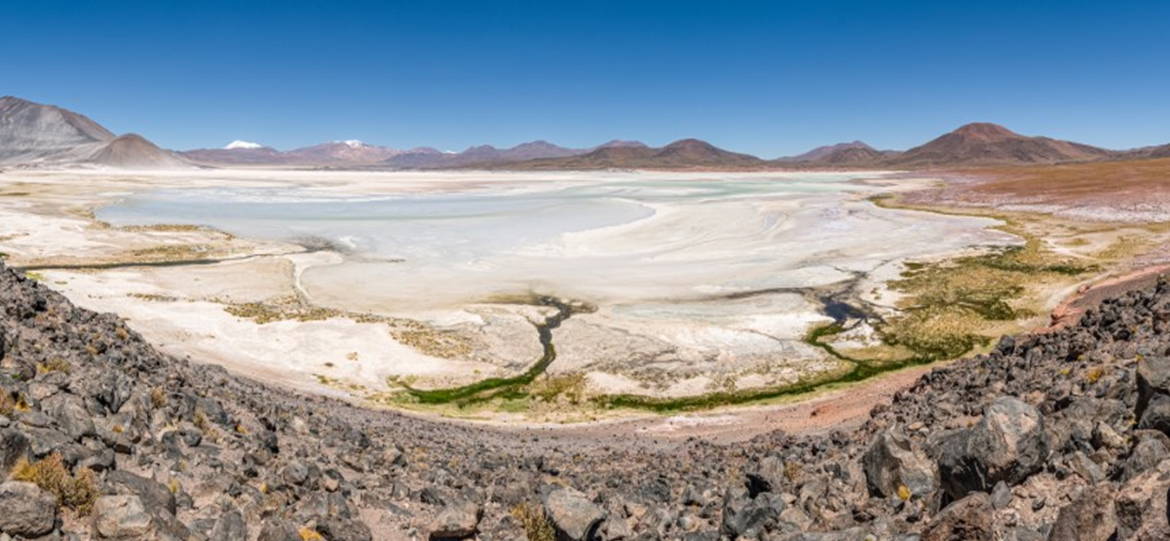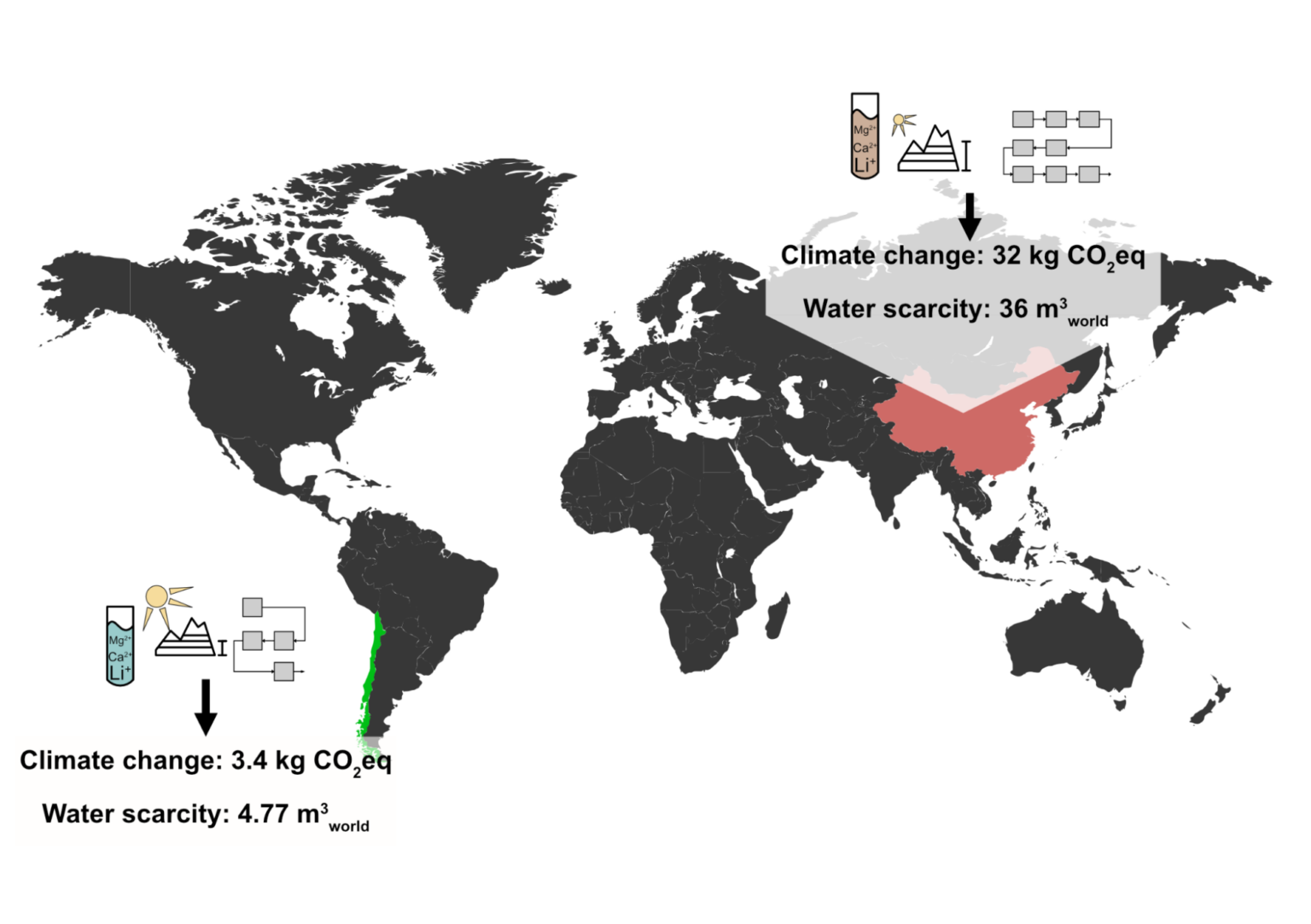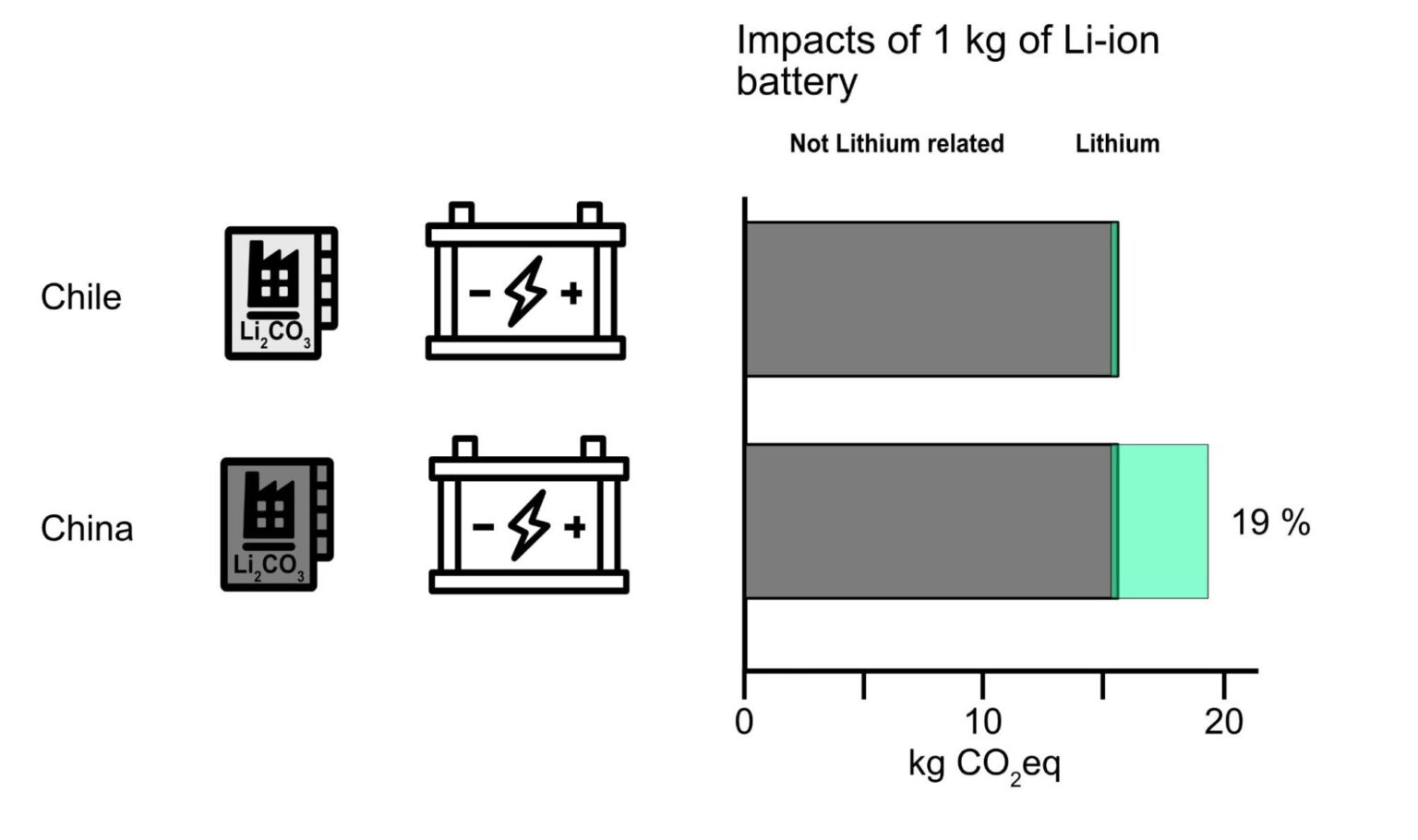
We need more transparent supply chains for a low-carbon society – the case of lithium mining
On 03.05.2023 by Vanessa SchenkerBy Vanessa Schenker

Vanessa is a PhD student at the Chair of Ecological Systems Design. She has a background in geology. Her PhD is dedicated to the assessment of environmental impacts related to metals which are crucial for low-carbon technologies.
Every time we calculate the environmental impacts of an electric vehicle, we use data from the lithium carbonate production at the Salar de Atacama in Chile. To meet soaring lithium demand, other, more polluting mining pathways are emerging. However, poor data availability is preventing proper accounting, leading to underestimated environmental damages. What we need are more transparent supply chains for a low-carbon society.
If we want to live in a low-carbon society, we need lithium. In the form of lithium-ion batteries, this metal will be required in tremendous amounts for the electrification of the mobility sector and energy storage systems. Currently, lithium is mainly mined from rocks in Australia and brines in Chile. Mines in Chile’s Salar de Atacama are currently the largest producers from brines and negatively impact the environment. For instance, burning fossil fuel contributes to the emission of greenhouse gases and water consumption jeopardizes ecosystems. Even worse, when comparing the climate change impacts of these two mining pathways, lithium from ores in Australia comes with higher greenhouse gas emissions compared to lithium from Salar de Atacama.
Looking into the future, the demand for lithium will skyrocket. But from where can we expect the lithium to come from and what are the associated environmental damages? As things stand, more than two-thirds of the global lithium resources are located in brines in salt flats in South America and salt lakes in China. Consequently, next to the currently operating mine in Chile’s Salar de Atacama, other brine deposits in Argentina and China also need to operate and extract lithium. The environmental conditions are unique at each location and the specialized technology used at Salar de Atacama is not applicable elsewhere. Thus, other technologies have been developed and modified for brines in Argentina and China, but some of these are known for their high water and/or chemical demand. Problematically, there is no data publicly available to assess potential impacts – so we don’t really know if lithium from other regions exacerbates environmental damages or not. In this post, I will argue that if we want to have a sustainable transition towards a low-carbon society, we need more transparent supply chains.
The most famous lithium mine around the globe
Salar de Atacama is one of the largest lithium deposits currently known. This salt flat is the result of ancient evaporated salt lakes. Lithium extraction has been active and constantly increased the production capacity for more than four decades (development of the infrastructure can be seen in Fig. 1). In a first step, the underground brine is pumped into evaporation ponds. Solar evaporation reduces the brine volume, salts precipitate, and, as a consequence, lithium is enriched in the residual brine. Once a certain concentration is reached, the brine is sent to the processing plant. Several steps are required to remove unwanted impurities and to obtain a highly concentrated lithium solution. As a final step, chemicals are added to let lithium carbonate precipitate
Figure 1: Timelapse (1984 – 2022) of Salar de Atacama mine development. Rectangles are the so-called evaporation ponds (the first step of the lithium extraction). Data is taken from Google Earth. Courtesy to Leopold Peiseler.
Life cycle assessment is a powerful tool to quantify environmental impacts but also to investigate the environmental hot spots along relevant supply chains. Specifically for this production route, company data for the Salar de Atacama is available. For climate change impacts, the main contributors are heat and chemicals. The heat is mainly based on fossil fuels but might be replaced by renewable energies in future. The production of chemicals (e.g., soda ash needed to produce the final lithium carbonate) is highly energy intensive and also based on fossil fuels. For instance, renewable energies could reduce the fossil fuel demand for soda ash production. Hence, these supply chains would need to be decarbonized as well to lower the climate change impacts of lithium carbonate production.
Consuming water in arid areas, like Salar de Atacama, might cause impacts on fragile wetland and lake ecosystems. There are two types of water demand when producing lithium carbonate: 1. the brine containing lithium and 2. freshwater used for lithium carbonate production directly on-site but also used within relevant supply chains (e.g., soda ash production). When quantifying water scarcity impacts by a method recommended by the United Nations Environmental Programme, only freshwater consumption is assessed by definition. From a life cycle assessment perspective, we find that the water scarcity impacts are more relevant regarding the freshwater used on-site compared to freshwater used in supply chains (e.g., chemical production and energy provision).
Due to its high salt content, brines are not accessible and/or usable by ecosystems and human beings and are therefore excluded in the aforementioned method. However, this does not mean that the effect of pumping the brine to the surface should not be investigated. Hydrogeological analyses are required to assess the effect on aquifers and ecosystems at Salar de Atacama. Research has shown that the decades of brine pumping has affected the hydrogeological systems in the Salar de Atacama. By using satellite images, the effects of surrounding ecosystems were investigated. The authors emphasized that other stressors, such as tourism and population increase, potentially impacting the local system at Salar de Atacama need to be further researched.
Lithium from other salt lakes in a Li-ion battery
Due to the increasing lithium demand, extraction only in Salar de Atacama will not be enough. Thus, salt lakes with elevated lithium concentrations in China and Argentina became interesting for lithium carbonate production. However, the lithium concentration in these deposits is lower than the one of Salar de Atacama and, unfavorable elements (e.g., magnesium or boron) lower the recovery rate of lithium when using the production route of Salar de Atacama. Consequently, other recovery technologies were investigated: for example, Chaerhan salt lake in China currently produces lithium carbonate using the so-called Li-ion selective adsorption technique. But how does this production route compare to the established route in Chile? Given the lack of publicly available data, in our recent study, we used patents to model the production routes in Argentina and China site-specifically. We considered environmental parameters, such as brine chemistry, annual temperature, and altitude, which affect lithium carbonate production. The technology applied at Chaerhan salt lake is characterized by its high freshwater and energy demand compared to the one at Salar de Atacama. When quantifying climate change and water scarcity impacts, we found that the impacts are roughly 10 times (!) higher than at Salar de Atacama (Figure 2).

Figure 2: Illustrative comparison of lithium carbonate production in Chile (Salar de Atacama) and China (Chaerhan salt lake). In this graph, the climate change and water scarcity impacts are provided for one kilogram of lithium carbonate. The effects of climate change vary considerably, with Chinese mining displaying nearly ten times the impact compared to mining operations in Chile.
This led inevitably to the question: What do these results mean for the production of a Li-ion battery? For the example of climate change impacts, using lithium carbonate from Chaerhan for a Li-ion battery increases these impacts by already 19% (Figure 3). Notably, this does not change the CO2 superiority of electric vehicles (EV) vs. combustion vehicles in most cases (feel free to experiment yourself using PSI’s carculator).
Our study clearly demonstrates that the origin of lithium significantly influences the effect on the global warming potential of lithium from different brine deposits to a Li-ion battery. In other words, if a battery actually contains lithium from the Chinese Chaerhan salt lake, given the lack of data, its climate change impact was underestimated so far.

Figure 3: Climate change impacts of the production of 1 kg Li-ion battery. The contribution of lithium from the location is highlighted in turquoise
Policies around the globe are getting more stringent not only regarding the climate change impact but also relating to fair and social supply chain practices (e.g., EU Supply Chain Due Diligence Directive). But how can such policies be enforced with opaque supply chains? Gladly, policymakers don’t only depend on supply chain transparency, they also influence it. Recent developments in the policy landscape emphasize that the origin of raw materials becomes more important (e.g., the US Inflation Reduction Act) and even threaten to exclude battery producers that rely on too carbon-intensive materials from the economic market (e.g., EU Battery Regulation). Concrete propositions how these ambitious goals can be achieved include the currently developed EU Battery Passport, a digital product “passport” that stores a multitude of information, including the origin of critical materials. This way, it will be in the best interest for players along the supply chain to be not only more transparent about their procurement and production but also to reduce operational and supply chain emissions.
We urgently need more transparent supply chains to be able to attribute environmental and social impacts accurately and to understand the effects of upstream industries, such as the mining sector. Furthermore, a standardized reporting of the carbon footprint is also needed to allow the development of efficient decarbonization strategies and simultaneously avoid severe environmental burden shifting. We call upon industrial actors, policymakers and consumers to respectively provide, facilitate and demand best efforts to quickly and substantially improve supply chain transparency.
Suggested citation: Vanessa, Schenker: “We need more transparent supply chains for a low-carbon society – the case of lithium mining”, Energy Blog @ ETH Zurich, ETH Zurich, May 03, 2023, https://blogt.ethz.ch/energy/lithium-supply-chain-transparency/
Referencing recently published work: https://www.sciencedirect.com/science/article/pii/S0921344922004451
If you are part of ETH Zurich, we invite you to contribute with your findings and your opinions to make this space a dynamic and relevant outlet for energy insights and debates. Find out how you can contribute and contact the editorial team here to pitch an article idea!
